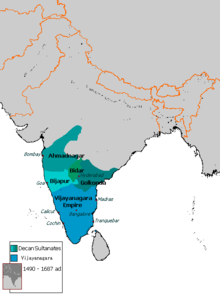顧特卜沙希王朝
顧特卜沙希王朝,或稱戈爾坎達蘇丹國,是16世紀初期在印度南部建立的高度波斯化的突厥王朝。由1518年生存至1687年被蒙兀兒帝國合併為止,它的成員統稱為庫塔布·沙希斯,位置在現在安德拉邦和泰倫加納邦。在王國存在時期不斷與鄰近的阿迪勒·沙阿王朝和艾哈邁德納加爾蘇丹國衝突。
| 顧特卜沙希王朝 | |||||||||
|---|---|---|---|---|---|---|---|---|---|
| 1518—1687 | |||||||||
|
國旗 | |||||||||
![Golconda in 1733 CE.[1]](http://upload.wikimedia.org/wikipedia/commons/thumb/c/ce/A_map_of_Golconda_region_from_1733%2C_published_by_Homann_Heirs_Nuremberg.jpg/250px-A_map_of_Golconda_region_from_1733%2C_published_by_Homann_Heirs_Nuremberg.jpg) Golconda in 1733 CE.[1] | |||||||||
| 首都 | Golconda (1519–1591) 海得拉巴(1591–1687年) | ||||||||
| 常用語言 | 波斯語(官方語言)[2] 泰盧固語[3] 德干烏爾都語 | ||||||||
| 宗教 | 什葉派 | ||||||||
| 政府 | Monarchy | ||||||||
| Qutb Shah | |||||||||
• 1512–1543 | Sultan Quli Qutb-ul-Mulk | ||||||||
• 1543–1550 | Jamsheed Quli Qutb Shah | ||||||||
• 1550–1550 | Subhan Quli Qutb Shah | ||||||||
• 1550–1580 | Ibrahim Quli Qutb Shah | ||||||||
• 1580-1612 | Muhammad Quli Qutb Shah | ||||||||
• 1612-1626 | Sultan Muhammad Qutb Shah | ||||||||
• 1626–1672 | Abdullah Qutb Shah | ||||||||
• 1672-1686 | Abul Hasan Qutb Shah | ||||||||
| 歷史 | |||||||||
• 建立 | 1518 | ||||||||
• 終結 | 1687 | ||||||||
| 貨幣 | Mohur | ||||||||
| |||||||||
| 今屬於 | India | ||||||||
在1636年,沙賈汗迫使戈爾坎達蘇丹國承認蒙兀兒帝國的宗主權,到1687年,當時莫臥兒皇帝奧朗則布征服了戈爾坎達蘇丹國。




歷史 編輯
王朝的創始人蘇丹·庫里·顧特卜·烏爾·莫爾克是來自伊朗哈馬丹的土庫曼人,在十六世紀初與他的叔叔安拉·古里一些親戚朋友一起遷徙到德里。後來他向南遷移到了德干,並服務於巴赫曼尼蘇丹穆罕默德沙。在巴赫曼尼王國解體為五個蘇丹國後,他征服了戈爾坎達,不久之後,他宣布獨立於巴赫曼尼蘇丹國,拿下了頭銜庫塔布·沙阿,並建立了獨立王國,
他在1543年被他的兒子詹姆西德殺死,後者被認為是儲君,他後來在1550年死於癌症。詹姆西德的小兒子蘇布罕只統治了一年,當時貴族擁立易卜拉欣·庫裡作為蘇丹。在穆罕默德·庫里·顧特卜沙希統治期間,印度教徒和穆斯林之間的關係得到加強,印度教徒甚至可以恢復傳統宗教節日,如排燈節和侯麗節。
一些印度教徒也在王國表現突出,最明顯例子是Madanna和Akkanna兄弟。
文化 編輯
庫塔布·沙希王朝的統治者也是偉大的建築師,最有名的例子是查米納塔門。同時他們也是學者贊助者,庫裡·顧特卜·烏爾·莫爾克的宮廷成為波斯文化和文學的天堂。蘇丹穆罕默德·古里·庫特沙(1580-1612)用達基尼語、烏爾都語,波斯語和泰盧固語中寫了詩,並留下了一個巨大的詩集。
最初,顧特卜沙希統治者贊助波斯文化,最終採納了以泰盧固語為代表的德干區域文化,雖然泰盧固語不是他們的母語,但戈爾坎達統治者說和寫泰盧固語,並且贊助泰盧固語,所以他們被稱為「泰盧固語蘇丹」。
他們的王朝被認為是印度教和穆斯林宗教社會文化的「複合體」。
參考 編輯
- ^ For a map of their territory see: Schwartzberg, Joseph E. A Historical atlas of South Asia. Chicago: University of Chicago Press. 1978: 147, map XIV.4 (l) [2021-10-27]. ISBN 0226742210. (原始內容存檔於2021-02-25).
- ^ Brian Spooner and William L. Hanaway, Literacy in the Persianate World: Writing and the Social Order, (University of Pennsylvania Press, 2012), 317.
- ^ Alam, Muzaffar. The pursuit of Persian: Language in Mughal Politics. Modern Asian Studies. 1998, 32 (2): 317–349. doi:10.1017/s0026749x98002947.
Ibrahim Qutb Shah encouraged the growth of Telugu and his successor Muhammad Quli Qutb Shah patronized and himself wrote poetry in Telugu and in Dakhni. Abdullah Qutb Shah instituted a special office to prepare the royal edicts in Telugu (dabiri-ye faramin-i Hindavi). While administrative and revenue papers at local levels in the Qutb Shahi Sultanate were prepared largely in Telugu, the royal edicts were often bilingual.'06 The last Qutb Shahi Sultan, Abul Hasan Tana Shah, sometimes issued his orders only in Telugu, with a Persian summary given on the back of the farmans.
Alam, Muzaffar (1998). "The pursuit of Persian: Language in Mughal Politics". Modern Asian Studies. Cambridge University Press. 32 (2): 317–349. doi:10.1017/s0026749x98002947. Ibrahim Qutb Shah encouraged the growth of Telugu and his successor Muhammad Quli Qutb Shah patronized and himself wrote poetry in Telugu and in Dakhni. Abdullah Qutb Shah instituted a special office to prepare the royal edicts in Telugu (dabiri-ye faramin-i Hindavi). While administrative and revenue papers at local levels in the Qutb Shahi Sultanate were prepared largely in Telugu, the royal edicts were often bilingual.'06 The last Qutb Shahi Sultan, Abul Hasan Tana Shah, sometimes issued his orders only in Telugu, with a Persian summary given on the back of the farmans.
